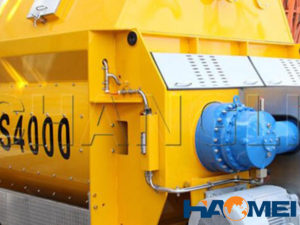In addition to the main units, a concrete mixer has many specialized components, including sealing parts, speed reducers, butterfly valve sealing circles, oil pressure meters, special bearings, V-type belts, water scale sensors, additive sensors, cement sensors, silo sensors etc, among which concrete mixer belts are an important part. After a period of usage, the belt gets worn, loose and even broken. It must be exchanged in time as the following steps.t
1. Open the front protective cover of the belt.
2. Remove the synchronous transmission shaft between the two speed reducers.
3. Regulate the adjusting bolts at the motor base and remove the old belt after the base gets lifted by around 50mm.

4. Get the new belt installed.
5. Tighten the adjusting bolts at the motor base and make the belt get strained. The straining degree can be judged by the following way. Give a pressure of 10kg onto the middle of the suspended belt and the deformation distance of the belt along the pressure direction should not be above 20mm.
6. Install the synchronous transmission shaft and check whether the phase angle between two mixing arms and mixing blades is the same as described in the manual. Check whether the two mixing shafts would effect each other by rotating them around a circle manually.
7. Install the protective cover of the concrete mixer belt.
During the whole exchanging process it’s not recommend to rotate the reducer pulley so that the phase angle of the two agitator shafts will not change and affect each other during future operation. The tension of a newly installed belt should be checked respectively after 10 hours and 50 hours. The belt must be tightened in case of slackness.
Reprinted from http://www.concretehm.com/exchange-concrete-mixer-belt.html